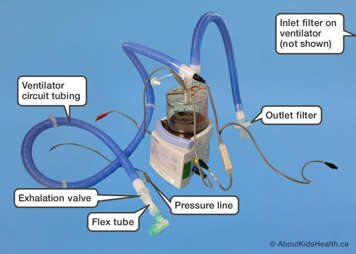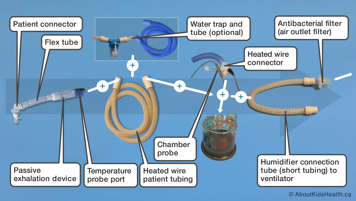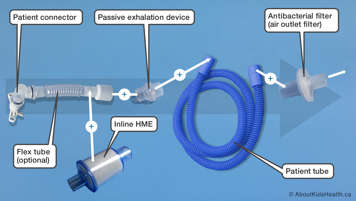What is a ventilator breathing circuit?
A ventilator breathing circuit is the connection between the ventilator and your child’s tracheostomy tube to allow airflow into and out of your child’s lungs.
There are different types of ventilator breathing circuits. Your child's health-care team will let you know the type of circuit that is best for your child. You will also learn how to connect and maintain the circuit before your child leaves the hospital.

Parts of a ventilator circuit
All ventilator circuits have the following parts:
- ventilator circuit tubing
- flex tube
- exhalation valve
- a pressure line
- an inlet filter
- an outlet filter.
Ventilator circuit tubing
This is usually about six feet long. One end of the tube attaches to an air outlet port and the other end attaches to an exhalation port.
When air needs to be humidified, a short tube is also used. This shorter tube goes from the air outlet port to the inlet of the humidifier pot. The long tube then attaches to the outlet of the humidifier pot to the exhalation valve.
Some circuit tubing has a heated wire, but others do not. The heated wire is designed to dry any condensation that builds up. If there is no heated wire, the circuit might instead include water traps to collect water build-up.
Exhalation valve
This is a vital part of a breathing circuit. There are active exhalation valves (active circuit) and passive exhalation valves (passive circuit).
When your child breathes in, an active exhalation valve closes so that the air from the ventilator can be directed into their lungs. When your child breathes out, the valve opens and directs the exhaled air out of the lungs.
The flex tube attaches to one end of the valve while the ventilator circuit tubing attaches to the other end.
Pressure line
This is a small tube that helps the ventilator measure air pressure (active circuit only-proximal pressure tubing). One end of the pressure line attaches to the ventilator and the other end attaches to the exhalation valve.
Inlet filter
This filters the air going into the ventilator.
Outlet filter
This filters the gas coming out of the ventilator and going into the circuit tubing.
Types of ventilator circuits
The Trilogy ventilator has four paediatric circuit types with tracheostomies:
- paediatric passive circuit, heated wire
- paediatric passive circuit without heat
- paediatric active circuit, heated wire
- paediatric active circuit without heat.
Paediatric passive circuit
This type of circuit is for children who are strong enough to trigger the ventilator. This circuit uses a passive exhalation device.
Parts of the passive circuit, heated wire
- Patient connector, with flex tube
- Passive exhalation valve
- Temperature probe port
- Heated wire ventilator circuit tubing
- Heated wire connector
- Chamber probe
- Humidifier connection tube
- Antibacterial filter (air outlet filter)
- Water trap and tube (optional)

Parts of the passive circuit without heat
- Patient connector, with optional flex tube
- Inline HME
- Passive exhalation device
- Patient tube
- Antibacterial filter (air outlet filter)

Active flow circuit
This circuit type is used when a patient cannot trigger the passive circuit. It allows the flow sensor and active exhalation device to respond to small changes in a child’s breathing.
The active flow circuit uses an active exhalation device. It also has a few more adjuncts (attachments) near to where the ventilator is connected to your child (exhalation valve line and two flow sensor lines). These adjuncts allow the air flow and pressure to be measured as close to the child as possible.
Parts of the active flow circuit, heated wire
- Patient connector, with flex tube
- Flow lines
- Flow sensor
- Active exhalation device
- Temperature probe port
- Exhalation valve line
- Heated wire patient tube
- Heated wire connector
- Water pot (chamber)
- Chamber probe
- Humidifier connection tube
- Antibacterial filter (air outlet filter)

Parts of the paediatric active flow circuit, without heat
- Patient connector, with optional flex tube
- Inline HME
- Flow sensor
- Active exhalation device
- Exhalation valve line
- Patient tube
- Antibacterial filter (air outlet filter)
